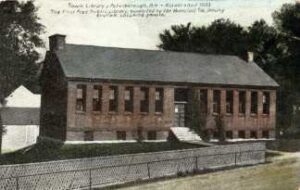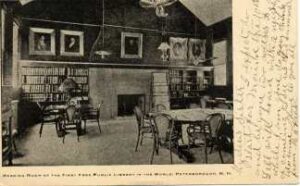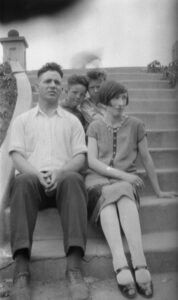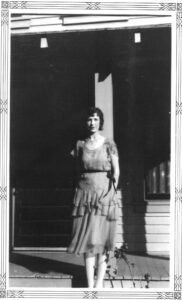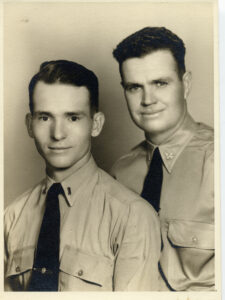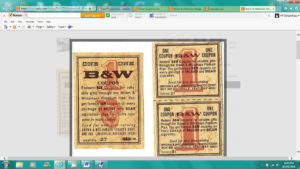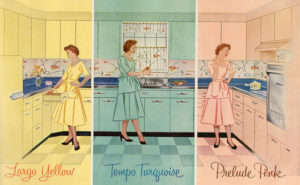by Debbie Burke
@burke_writer

Josie family album
Food can lead to a bountiful banquet of stories.
Not long ago, I enjoyed a week-long visit with an old friend to celebrate her 96th birthday. Josie is Greek and has a well-deserved reputation as a legendary cook. She makes the best baklava I’ve ever tasted. Phyllo, melted butter, honey, cinnamon, phyllo, more butter, chopped nuts, more butter. Layer after layer of pure heaven.
Years ago, one of my relatives was getting married and asked Josie to make Greek food for the wedding. Apprentice volunteers (including myself) spent the weekend in her kitchen and dining room, under the gentle but exacting guidance of our revered goddess of Greek cooking.
Josie showed us how layer baklava and how to stuff grape leaves (dolmades) along with sharing her secret marinating tricks for roast leg of lamb (slivers of garlic embedded all over the meat along with spices and olive oil).

Spanakopita – Photo credit: terri_bateman, CC0, via Wikimedia Commons
The most labor-intensive dish was spanakopita. Phyllo dough is filled with cheese, spinach, and egg then folded flag-style into triangular pastries, brushed with melted butter, and baked. Each one takes about five minutes to carefully fold, but only five seconds to melt in your mouth.
Phyllo is more delicate than 3000-year-old parchment scrolls. When the tissue-thin dough tore as I handled it, that ruined the perfect appearance required for the fancy party. Of course, I had to eat my mistakes and, wow, did I goof up a lot!
The Greek food at the wedding was a huge hit. Prior to this cooking marathon, Josie and I had been friends, but that weekend sealed our close bond forever.
During my recent visit for Josie’s birthday, we went through her dresser drawerful of old recipes. Some were in cookbooks with many margin notes added in ink; others were on paper or index cards in her neat, careful handwriting. The pages were stained with butter, olive oil, chocolate, and other evidence of intense use.
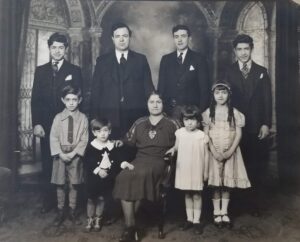
Josie’s family album. She is the girl on the right.
I learned her mother was a first-generation immigrant from the island of Patmos who didn’t know how to read or write. She was a wonderful cook but never used measuring cups or spoons. Memorializing her mother’s recipes in writing took considerable time, experimentation, and guesswork. The effort was worth it.
Fascinating historical tidbits came out in our conversations over the recipes. “During wartime, when there was no food, Greeks didn’t starve like other countries because they ate greens. They went out in the country and picked wild greens. And that kept them from starving.”
Josie recalled picking dandelions to eat in the spring when she was a child. “I wasn’t crazy about them, but my mother insisted.”
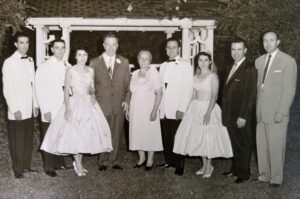
Josie’s family as adults
Her family consisted of five boisterous boys and two girls. “Growing up with five brothers, I learned to hold my own. I wasn’t easily intimidated.”
Seven kids kept their parents busy trying to feed them during Prohibition and the Depression. Her father, whom she called the “original Nick the Greek,” made ouzo in a still in their basement.

Josie’s dad, Nick the Greek
Nick was an early pioneer of route sales. Every day, he walked around their neighborhood, pushing Josie in a baby carriage. He stopped to chat with friends who admired Nick’s adorable toddler in the carriage. After a few minutes of visiting, each walked away with a bottle of ouzo that had been hidden in her blankets.
She also recalled men coming to their house in the middle of the night. Nick always welcomed them. They joked and chatted for a while, then left.
“Why do those men come here so late?” Josie asked her mother.
“Never mind, they’re just visiting.”
She later figured out they were Nick’s satisfied midnight customers.
When she taught her father how to sign his name, he was very proud of that accomplishment.
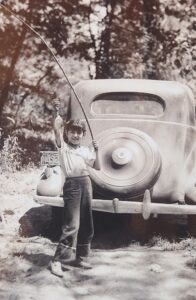
Josie caught a fish for dinner
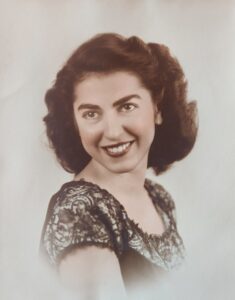
Josie high school graduation photo 1945
Our conversation turned to her early jobs. At 18, she moved from Pennsylvania to Brooklyn. There, she managed a coffee store on Smith Street near Flatbush Avenue. The owner liked her because her accounts always balanced to the penny…except for one problem customer.
A man came in every morning and stole a newspaper. He was a big guy and evidently hid the paper under his arm. She could never catch him in the act, but she knew his habits. After stealing the paper, he would walk around the corner and have breakfast at a cafe.

Flatbush Avenue
Photo credit: Wikimedia.com
One day, she followed him to the cafe and sat down at the counter on the stool beside him. While waiting for their breakfast orders, she engaged him in friendly conversation. She kept pleasantly chatting as he grew visibly more nervous. Finally, she said, “You know, it’s hard for small businesses to survive. Even losing a single newspaper makes a difference.”
“All right! All right! I did it!” the man blurted out. “I’ll pay!”
Her gentle, non-accusatory appeal to his conscience worked. From that day forward, he always paid.
The young woman working alone in a store could have made a tempting target. But Josie received protection from two unlikely bodyguards.
Lou was a burly Italian bookie operating in the neighborhood who made sure no one bothered her. Once, she fell seriously ill with the flu. Lou took her home to his apartment where his wife nursed her back to health with homemade soup. She slept on their couch until she recovered and was forever grateful for their kindness.
The second bodyguard was a so-called “hobo” who met her bus every morning and walked her to the coffee store. Each night, he walked her from the store to the bus stop. “You don’t need to do this,” she told him. He just smiled and continued to escort her.
One night, he was murdered—knifed in a doorway. When she learned about his death, she was heartbroken. “He was so nice to me and never expected anything in return.”
Another early job was in a mill on the Ohio River. The factory made plating to line soup cans. She worked in the lab, testing tin samples because different soup ingredients required different formulations of tin. Inspectors visited often to check compliance for food safety. Before hearing her story, I thought a soup can was simply a soup can.

Josie’s siblings and in-laws
Here’s a festive meal with Josie’s siblings and in-laws. She’s not in the photo perhaps because she was in the kitchen, refilling platters with more goodies.
Starting with recipes, Josie took me on a week-long journey into the past.
Recipes are like old family Bibles and photo albums, rich with history and memories. I learned fascinating facts and anecdotes that never make it into history books. Yet such rich details add texture, color, and verisimilitude to stories about bygone days. Josie’s stories gave me the itch to dive into historical fiction.
I visited for her birthday but I’m the one who left with a precious gift.
~~~
TKZers: Do you have written family histories, or recordings of oral histories?
Do people and stories from the past inspire your work?
What is your favorite source for historical details?
~~~

Ninety-six-year-old Josie is a fan of the Tawny Lindholm Thriller series but has one criticism: “Honey, I wish you’d add a little more sex!”
I’ll take your suggestion to heart, Josie!














